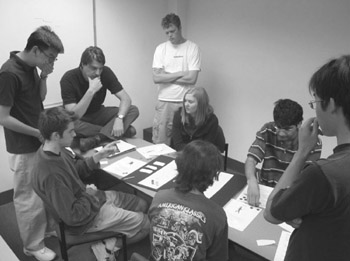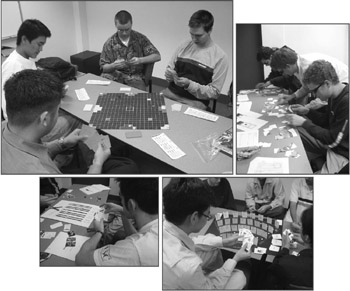An Advocate For the Player
|
| < Day Day Up > |
|
The role of the game designer is, first and foremost, to be an advocate for the player. The game designer must look at the world of games through the player's eyes. This sounds simple, but you'd be surprised how often this concept is ignored. It's far too easy to get caught up in a game's graphics, storyline, or new features and forget that what makes a game great is solid gameplay. That's what excites players. Even if they tell you that they love the special effects, art direction, or plot, they won't play for long unless the gameplay hooks them.
As a game designer, a large part of your role is to keep your concentration focused on the player experience and not allow yourself to be distracted by the other concerns of production. Let the art director worry about the imagery, the producer stress over the budget, and the technical director futz with the engine. Your main job is to make sure that when the game is delivered, it provides superior gameplay.
When you first sit down to design a game, everything is fresh, and, most likely, you have a vision for what it is that you want to create. At this point in the process, your view of the game and that of the eventual new player are similar. However, as the process unfolds and the game develops, it becomes increasingly difficult to see your creation objectively. After months of testing and tweaking every conceivable aspect, your once clear view can become muddled. At times like this, it's easy to get too close to your own work and lose perspective.

Figure 1.1: Playtest group
Playtesters
Situations like these are when it becomes critical to have playtesters. Playtesters are people who play your game and provide feedback on the experience so that you can move forward with a fresh perspective. By watching other people play the game, you can learn a great deal.
Observe their experience and try to see the game through their eyes. Pay attention to what objects they are focused on, where they click or move the cursor when they get stuck or frustrated or bored, and write down everything they tell you. They are your guide, and it's your mission to have them lead you inside the game and illuminate any issues lurking below the surface of the design. If you train yourself to do this, you will regain your objectivity and be able to see both the beauty and the flaws in what you've created.
Many game designers don't involve playtesters in their process, or, if they do bring in playtesters, it's at the end of production when it's really too late to change the essential elements of the design. Perhaps they are on a tight schedule and feel they don't have time for feedback. Or, perhaps they are afraid that feedback will force them to change things they love about their design. Maybe they think that getting a playtest group together will cost too much money. Or they may be under the impression that testing is something only done by marketing people.
What these designers don't realize is that by divorcing their process from this essential feedback opportunity, they probably cost themselves more time, money, and creative heartache than not. This is because games are not a form of oneway communication. Being a superior game designer isn't about controlling every aspect of the game design or dictating exactly how the game should function. It's about building a potential experience, setting all the pieces in place so that everything's ready to unfold once the players begin to participate.
In some ways, designing a game is like being the host of a party. As the host, it's your job to get everything ready-food, drinks, decorations, music, to set the mood-and then you open the doors to your guests and see what happens. The results are not always predictable, or what you envisioned. A game, like a party, is an interactive experience that is only fully realized once your guests partake of the punch. What type of party will your game be like? Will your players sit like wallflowers in your living room? Will they stumble around trying to find the coatroom closet? Or will they jabber and chatter away, hoping the night will never end?
Inviting players 'over to play' and listening to what they say as they experience your game is the best way to understand how your game is working. Gauging reactions, interpreting silent moments, studying feedback, and matching those with specific game elements are the keys to becoming a professional designer. Once you learn to listen to your players, you can help your game to grow.
In Chapter 8 on page 196, when we examine the playtesting process in detail, you'll learn methods and procedures that will help you hold professional-quality playtests, and make the most of these tests by asking good questions and listening openly to criticism. For now though, it's just important to know that playtesting is the heart of the design process explored in this book, and that the feedback you receive during these sessions can help you transform your game into a truly enjoyable experience for your players.
Like any living system, games transform throughout their development cycle. No rule is set in stone. No technique is absolute. No scheme is the right one. If you understand how fluid the structures are, you can help mold them into shape through repeated testing and careful observation. As a game designer, it's up to you to evolve your game into more than you originally envisioned.
That's the art of game design. It's not locking things in place; it's giving birth and parenting. No one, no matter how smart they are, can conceive and produce a sophisticated game from a blank sheet of paper and have it perfected without going through this process. And learning how to work creatively within this process is what this book is all about.

Figure 1.2: More playtest groups
Exercise 1.1: Become a Tester
Take on the role of a tester. Go play a game and observe yourself as you play. Write down what you're doing and feeling. Try to create one page of detailed notes on your behaviors and actions. Then repeat this experience while watching a friend play the same game. Compare the two sets of notes and analyze what you've learned from the process.
Throughout this book, we've included exercises that challenge you to practice the skills that are essential to game design. We've tried to break them down so that you can master them one by one, but by the end of the book, you will have learned a tremendous amount about games, players, and process. And, you will have designed, prototyped, and playtested at least one original idea of your own. We recommend creating a folder or notebook of your completed exercises so that you can refer to them as you work your way through the book.
|
| < Day Day Up > |
|
EAN: 2147483647
Pages: 162
- ERP Systems Impact on Organizations
- Challenging the Unpredictable: Changeable Order Management Systems
- Enterprise Application Integration: New Solutions for a Solved Problem or a Challenging Research Field?
- Distributed Data Warehouse for Geo-spatial Services
- Intrinsic and Contextual Data Quality: The Effect of Media and Personal Involvement